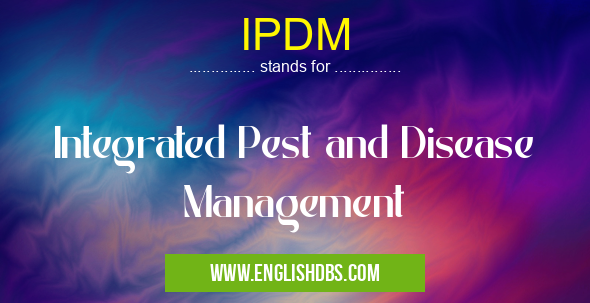What does IPDM mean in DISEASES
Integrated Pest and Disease Management (IPDM) is a popular method of preventing and controlling pests and diseases in agricultural settings. It involves the use of numerous strategies and tools to reduce insect, weed, and disease damage in food production. This approach combines cultural, chemical, genetic, biological, legal, economic, educational, mechanical, physical and other treatments into an effective pest-management program. IPDM is an important tool for sustainable development and agricultural production worldwide.

IPDM meaning in Diseases in Medical
IPDM mostly used in an acronym Diseases in Category Medical that means Integrated Pest and Disease Management
Shorthand: IPDM,
Full Form: Integrated Pest and Disease Management
For more information of "Integrated Pest and Disease Management", see the section below.
Benefits of IPDM
Adopting preventative strategies based on the principles of Integrated Pest and Disease Management has significant benefits for both farmers and consumers alike. By avoiding large amounts of pesticide use, crops will have lower residual levels of chemicals which can be hazardous to human health when consumed over long periods of time. Reduced levels of pesticide also benefit natural ecosystems by protecting animal biodiversity from environmental pollutants. Additionally IPDM often increases yields since incorrect application or overuse of pesticides can actually result in decreased yield over time due to decreased soil fertility caused by these materials leaching into the earth’s water systems.
Essential Questions and Answers on Integrated Pest and Disease Management in "MEDICAL»DISEASES"
What is IPDM?
IPDM stands for Integrated Pest and Disease Management. It refers to the practice of using a variety of methods to achieve sustainable pest and disease control in order to protect crops, livestock, and other agricultural products from pests and diseases. These methods can include physical barriers, traps, natural predators, chemical controls such as insecticides and fungicides, and cultural practices such as crop rotation.
How does IPDM help protect crops?
IPDM helps protect crops by creating barriers between them and potential threats. This includes physical barriers like fences or covers that prevent pests from entering fields; traps that catch invading pests; natural enemies like predators that reduce pest populations; chemical controls such as insecticides and fungicides that target specific pests; and cultural practices such as crop rotation that disrupt pest life cycles.
What are the benefits of IPDM?
IPDM has several benefits for farmers. It allows them to reduce their reliance on potentially hazardous chemical pesticides, which can have negative impacts on human health, environment quality, farm profitability, and marketability of products. It also helps them to maintain their crops' health by removing potential threats before they cause significant damage. Furthermore, it reduces production costs since fewer chemicals need to be purchased or applied.
Are there any drawbacks to implementing IPDM?
Implementing IPDM can involve a considerable amount of labor for farmers due to the need for monitoring, scouting operations, proper application of pesticides if needed, recording information about pest populations etc., which can be time-consuming and costly. Additionally, some practices used in IPM may not be effective against certain pests or diseases if not implemented correctly or if conditions change quickly (e.g., sudden changes in weather).
What strategies are used in IPDM?
A range of strategies may be used in an IPDM program including physical barriers like fences/covers; trapping; biological controls involving the use of natural predators to control pests; chemical controls such as insecticides/fungicides when absolutely necessary; cultural practices such as crop rotation; alternate cropping patterns/cultivars selection; sanitation & hygiene measures like surface cleaning etc.; legal regulation through agricultural policymaking etc..
Is IPM different from IPM?
Yes - Integrated Pest Management (IPM) refers to an overall approach combining multiple methods for managing pest populations while Integrated Pest & Disease Management (IPDM) is primarily focused on protecting crops from both insect pests as well as plant disease-causing organisms (pathogens). The latter requires strategies that specifically address fungal or bacterial pathogens in addition to insects etc..
How do you know when Control Measures should be implemented?
In order for an effective Integrated Pest & Disease Management system to be put into place it is important to understand where along a pest’s lifecycle certain control measures should be implemented in order maximize effectiveness - this means having a clear understanding of population dynamics including migration patterns & levels at which action needs to be taken prior too large scale economic loss occurring.
What factors should you consider before deciding on a Control Measure?
Before deciding upon any particular control measure within an IPM program one should consider the cost-benefit ratio associated with the measure itself taking into account both economic viability & environmental considerations - this may involve looking at long term effects regarding resistance development or persistence in soils & aquatic ecosystems.
How often should scouting take place during an IPM Program?
Scouting activities form part of any successful IPM program - frequent monitoring is necessary so timely solutions can be put into place based upon up-to-date knowledge regarding various parameters which include population size/density thresholds at which action needs taking. Nevertheless exact frequency will depend upon factors such cost/availability resources but typically ranges between weekly up through monthly intervals.
Final Words:
Integrated Pest and Disease Management is a valuable tool that all farmers should become familiar with in order to ensure their crops are produced safely and sustainably while yielding optimal results at harvest time. By utilizing cultural practices such as crop rotation; biological controls like beneficial insects; physical removal methods like hand picking; chemical treatment only when necessary; selecting resistant plant varieties; understanding weather patterns; maintaining proper sanitation methods; educating farm workers about safety protocols; understanding state laws regarding pesticide usage; strategic financial planning etc., farmers can successfully implement an IPM plan that meets their specific needs while realizing increased profits over time.
